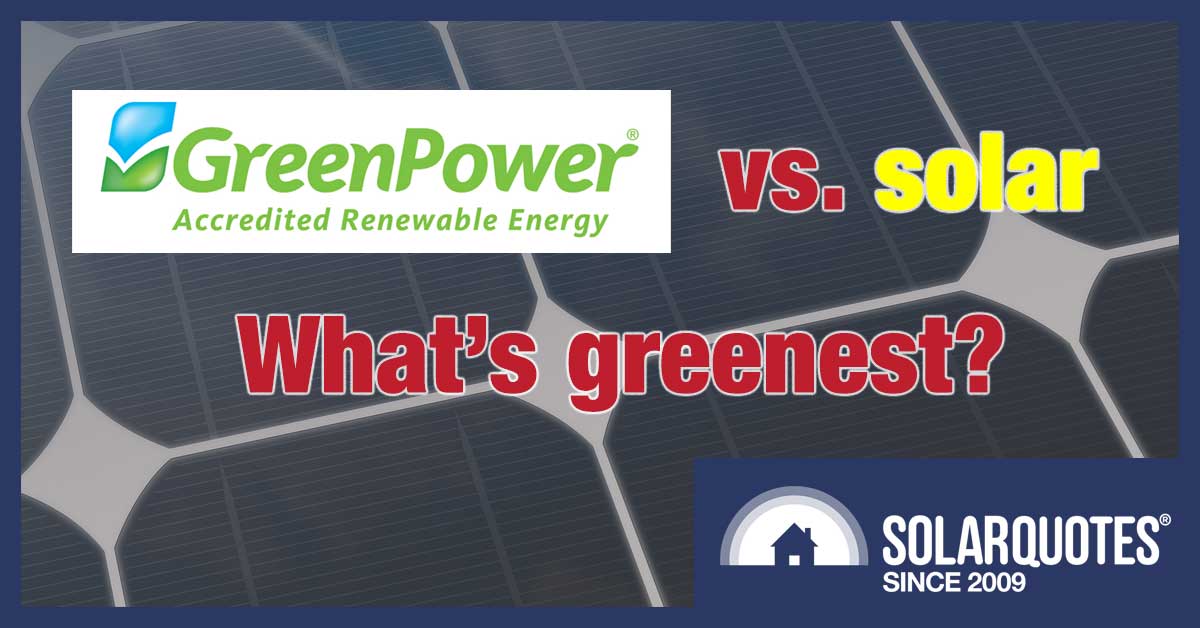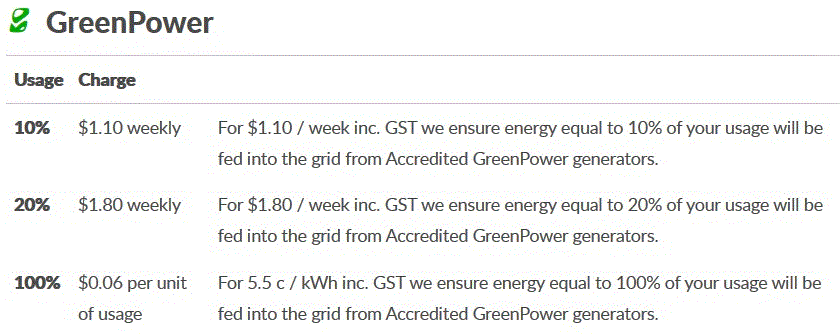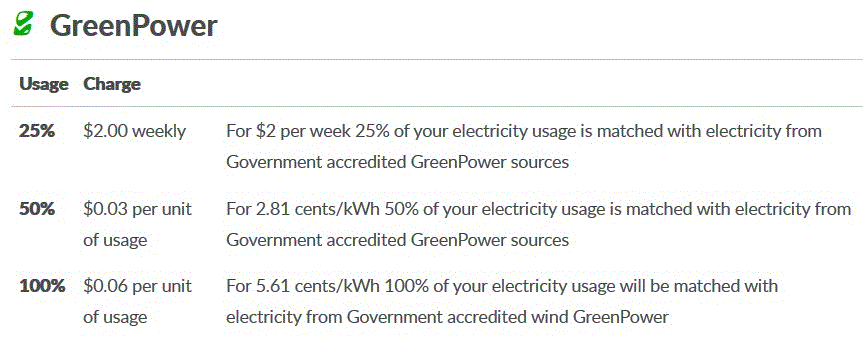
A while back a reader asked me for a post on rooftop solar vs. Green Power. Or, if you spell as badly as a government national program — GreenPower. So here it is:
Rooftop solar power is far better than GreenPower.
Done.
That was easy. I guess it’s time to have lunch.
But before I eat I should probably explain how I arrived at that conclusion. Also, it wouldn’t be fair to GreenPower1 if I didn’t point out it’s a good thing for the environment and our lungs. If you want to be extra clean and green you should get both.
In this article I’ll explain why rooftop solar is better for your wallet. Fortunately, it’s an easy concept to get across — rooftop solar power decreases your electricity bills while GreenPower increases them.
I’ll also explain what GreenPower is, how much it costs, and why it’s likely to get cheaper. I’ll also cover why a large enough rooftop solar power system can be better for the environment than paying for 100% GreenPower.
What The Hell Is GreenPower?
GreenPower is a national scheme that allows households to contribute to the generation of renewable energy through an extra charge on their electricity bills that is used to pay for renewable energy certificates. It’s available from 25 electricity retailers through Australia.
The portion of your grid electricity use covered by renewable energy certificates purchases depends on your GreenPower plan and can range from 10% to 100%. How much it costs partly depends on your electricity retailer. As an example, here are the GreenPower options AGL offers with one of their electricity plans:
This is the first time so far in the article I’ve presented information from an electricity retailer and already we’ve run into the sort of shenanigans that make them such a joy to deal with. For 100% GreenPower they say the price is 6 cents per unit but they also say it is 5.5 cents. The chat feature on their website is down, so it appears I have no choice to find out the correct figure other than to call them.
Well, that was less painful than usual.
It turns out the 6 cent figure isn’t the actual price, it’s just 5.5 cents rounded up. I’m surprised they didn’t make it 5.49 cents so it would be rounded down to 5 cents and look cheaper.
Wait a minute… If I’m now thinking of evil things AGL didn’t think of, does that make me more evil than an electricity retailer?
Here is what Origin Energy charges:
At the moment their 100% GreenPower option is a little more expensive than AGL.
GreenPower Looks Like A Ripoff
The type of renewable energy certificates purchased with the money spent on GreenPower are called Large-scale Generation Certificates or LGCs for short. At the moment they cost $39 per megawatt-hour. There are 1,000 kilowatt-hours in a megawatt-hour, so by doing some advanced calculations using all 10 of my fingers, I can determine they cost 3.9 cents per kilowatt-hour. That’s about 40% less than what AGL charges for 100% GreenPower.
It can be much worse if you have 10% or 20% GreenPower where you pay a fixed amount of $1.10 or $1.80 per week. If annual household grid consumption is 5,000 kilowatt-hours a year, which is typical for homes without solar panels, then you will be paying:
- 10% GreenPower: 11.5 cents per GreenPower kilowatt-hour
- 20% GreenPower: 9.4 cents per GreenPower kilowatt-hour
So you’ll be paying 2.4 to 2.9 times the cost of the certificates.
But AGL doesn’t rake in all the difference as 10% of the charge is GST. While I enjoy a good bit of taxation every now and then, discouraging people from saving the planet is probably not the best way to go about it.
You May Be Better Off Doing It Yourself
Rather than pay for GreenPower it may be cheaper to simply buy LGCs yourself and just sit on them. I suppose I should try to buy an LGC for myself and see how it goes. I’ll let you know how it turns out.
GreenPower Is Getting Cheaper
GreenPower is much cheaper than it used to be. This is because the cost of LGCs has fallen by more than 50% in two years. Because Australia’s Large-scale Renewable Energy Target has been filled and is winding down they are expected to continue to fall in price. According to future market estimates, in a year they may be only 2.3 cents per kilowatt-hour and in 2022 they might only be around 1 cent per kilowatt-hour. So GreenPower should get a lot cheaper, even if retailers continue to charge a lot more than LGCs cost.
GreenPower Becoming Less Green?
The cost of renewable energy is falling fast, but not nearly as fast as LGC prices. This means each LGC bought will pay for less new renewable generating capacity than in the past. On the other hand, solar power and wind energy are much more competitive than they were, so this is much less of a problem. It is not clear if LGCs will continue to reduce emissions in the same way as now their price is falling.2 But what is clear is buying LGCs, either directly or through GreenPower, will continue to support clean energy generation for as long as their price stays above zero.
Solar Saves Money While GreenPower Costs Money
Rooftop solar power and GreenPower are two very different things. Rooftop solar is a direct investment in renewable solar electricity generation that provides clean energy and often pays for itself in under 5 years. It works to lower electricity bills from the moment it is switched on.
GreenPower is an extra charge on your electricity bill that, after GST and retailer margin, goes towards buying renewable energy certificates. It is helpful and does reduce CO2 emissions and air pollution. But it’s only useful to people who care about things like climate stability, protecting the environment, and those annoying things called children. If your heart is full of pure evil, or you happen to be Tony Abbott, then you probably won’t be willing to pay for it. But even someone who is convinced there is no such thing as global roasting can still see the benefit of investing in solar power to save money.
Rooftop Solar Power Can Be Better For The Environment
Unless you start buying LGCs yourself — which may not be a bad idea — you cannot get more than 100% GreenPower. But it is possible to do better than that with rooftop solar. If a system produces more kilowatt-hours on average than the household consumes then solar will be more effective than 100% GreenPower at reducing emissions and air pollution.
Most homes are able to install a 6.5 kilowatt solar power system that will typically produce over 9,000 kilowatt-hours a year. This is considerably more than the typical annual household consumption of roughly 5,000 kilowatt-hours.
Solar Plus GreenPower
If you want to be kind to your fellow humans and also puppy dogs and duck-billed platypuses, then you can get both solar panels and GreenPower. This is what my boss, Finn, does. I don’t have GreenPower because I assumed contributing to getting solar systems built would be more cost effective. For example, after I get my tax return done this year, I’ll see if I can finally afford to get my sister solar power. Don’t tell her I’m willing to pay for it! I’m still hoping to convince her to shell out for it.3
But there’s no real reason why I couldn’t get GreenPower as well as solar. Even at today’s prices it would only cost me around $100 a year. However, it may be more cost effective to simply buy renewable energy certificates and then use them as toilet paper4 so no one else will ever use them to offset emissions. So I’ll see if I can buy an LGC for myself and if I’m successful I’ll let you know how it’s done.
Footnotes
- It should be called Green Energy rather than GreenPower since it’s based on how much energy you use, not how much power you draw, but to tell the truth I’m just glad they didn’t throw the word “quantum” or “blockchain” in there — GreenQuantumCyberBlockchainEnergyMegaPower! ↩
- It would be necessary to change some of the claims retailers make about GreenPower if it becomes less effective at reducing emissions. ↩
- I’m guessing she can afford to pay for it herself. I don’t know what job she has at the moment, but she is very bossy, so I assume she is dictator of at least a small country. ↩
- Might have to be in a virtual toilet though, since they’ll just be ones and zeros. ↩




 RSS - Posts
RSS - Posts



Hi Ronald,
I have a question about the energy fed back into the grid by my solar panels. Does my energy retailer get to sell that energy back to someone else as GreenPower? Or does GreenPower have to come only from LGC certificates?
Hi Martin
GreenPower only comes from LGC certificates. Rooftop solar creates STCs which are Small-scale Technology Certificates. These get given up front when a system is installed and are included in its price and lower the cost of solar for households. As your rooftop solar has already created renewable energy certificates it can’t be used to create any more.
I have not read the whole of this article but it seemed to me, whenever I took note of the Green Power thing that, again, they are asking me to foot the (extra) bill. If the Energy Gods who bill us make so much profit that they can foot the bill for this wonderful idea and leave me alone to pay my energy bill (less the benfit of having solar panels).
Hi Grace,
If you read the full article you will see that it makes it quite clear that ‘roof-top solar PV and ‘Green Power’ are two quite separate things. You don’t have to sign up for both. ( or did I mis-interpret what you wrote? Do you already have solar panels?)
I’ve got solar PV myself, and that also means I’m already doing my bit for the environment. On top of that, I’m also ‘subsidizing’ the electricity retailer by the difference between the FIT I’m paid for my exports and the retail price that the retailer charges to some-one else for using those.
Over the life-time of my system that ‘subsidy’ adds up to a substantial amount of money, and quickly repays any initial STC rebate on my system cost as well. eg… you might get an STC rebate of (say) $3800 off your initial cost, but when your system starts producing, you immediately start to ‘repay’ that rebate back on a daily basis – assuming you’re exporting of course.
Dear Des,
I, indeed, have 14 solar panels. And I do not sign up for Green Power as I just want to pay less on my energy bill and have other ways of saving our precious planet. I am probably missing the point but it’s a point I could not care less about. But thanks very much for your kind reply.
Hi Ronald
I think your discussion is missing something very important, i.e. that selling your STC means you have sold your emissions reductions to someone else and can’t claim the moral credit for them any more.
Likewise I think that if you are currently purchasing green power, and you switch to rooftop solar, your net emissions will increase unless you don’t claim your STCs.
When I first started thinking about it I found that argument rather depressing, so being an Engineer I made a worked example for myself to make sure my gut feeling was accurate; I’m interested to hear if you see any assumptions which aren’t right
I lay out the two scenarios as follows, in terms of the green energy my actions are supporting:
Before I installed solar:
my daily average purchase: 15 kWh/day @ 100% greenpower (which AGL purchases on my behalf using LGC)
In addition to this, AGL must also purchase 116 STC of green energy to meet their other renewable energy obligations.
Scenario 1:
After I install solar, if I sell my STC to AGL (or other retailer):
my daily average purchase: 5 kWh/day @ 100% greenpower
my daily average generation: 30 kWh/day of solar
AGL don’t need to purchase those 116 STC any more. The 116STC they would have bought from someone else is supplied by burning gas or coal instead.
The STC are calculated so that my daily average generation roughly corresponds to the 116 STC, i.e. the two of these cancel out, so overall in this scenario I am now only directly supporting 5 kWh/day of greenpower, down from 15 kWh/day before.
Alternatively:
Scenario 2:
After I install solar, if I keep my own STC (voluntary surrender):
my daily average purchase: 5 kWh/day @ 100% greenpower
my daily average generation: 30 kWh/day of solar
AGL still need to purchase 116 STC of green energy (and what’s more, it costs them slightly more than if my STC were on the market, making it more profitable for green energy suppliers and hence slightly increasing the supply of green energy further).
So overall in this scenario, I have increased the total green energy from 15 kWh/day + 116STC to 35 kWh/day + 116STC.
I.e. by buying solar and selling my STC I have actually increased my netemissions, which is the exact opposite of what you conclude in your article.
Cheers
Richard
Hi Richard
Fortunately, LGCs and STCs are not interchangeable. This means an electricity retailer cannot use the STCs created when your solar system is installed to offset its LGC requirements. So a household can get rooftop solar and it won’t have any effect on how many LGCs have to be surrendered. They are effectively two separate schemes that work differently.
Hi Ronald
I think that, although LGC and STC are handled as separate markets, they are parallel schemes and the principle is the same regardless of whether I’m selling STC or LGC.
i.e. someone is being forced to buy STC. If I sell my STC, it means they no longer have to buy them elsewhere. This causes the demand for them to drop and the price to decrease. So the net result is that less STC are created. For some reason the phrase “elasticity of supply and demand curves” leaps into my mind which is very distressing really since I find economics in general to be soul-destroyingly dull. Perhaps this is a good question for those Freak-o-nomics guys.
After a lot of rationalising I’ve convinced myself that 1 STC (energy over 12 years) is probably less than what the system will eventually produce over its lifetime, and that me selling 1 STC into the market will reduce supply by only a fraction of that 1 STC, so selling the STC doesn’t completely negate my carbon savings.
Cheers
Richard
LGCs were designed so Australia would reach its Large-scale Renewable Energy Target. Now that we are going to exceed the target the price of LGCs is falling. But STCs are designed to keep the installation of rooftop solar relatively constant and while the amount of STCs given for rooftop solar each year, one of the goals is to keep the price of STCs fairly constant. This means if more STCs are created than expected in a year it can result in the number retailers need to surrender being increased in the next year. So hanging onto your STCs instead of using them to lower the cost of your solar system may not be the best thing to do from an environmental point of view.
At the moment a typical rooftop solar system will create 16.6 STCs per kilowatt of solar panel capacity when installed. This is supposed to represent 16,600 kilowatt-hours of renewable electricity. A typical kilowatt of rooftop solar will generate that much in around 12 years or less. While there are crap systems that won’t last that long, on average rooftop solar should be producing considerably more clean energy than the STCs cover.
OK that makes sense. The regulator adjusts the demand to match the expected supply, so if you surrender your STC then the demand goes down in the next year, i.e. the “liable entities” (electricity retailers) don’t need to buy as many. So the effect of surrendering your STC instead of selling them is to reduce the amount of money paid by the retailer, presumably reducing the cost of electricity for their customers.
Although it’s not a rebate, it sure behaves a lot like a rebate. If you don’t purchase, the manufacturer doesn’t have to come up with the money.
The third option – if you create the STC but then don’t sell them and don’t surrender them either – they stay in the liability calculations, which pushes up the price because the supply is reduced. Which tends to encourage more people to install solar, because they get a greater discount for their STC. So perhaps that’s the greenest of all. But I imagine that the supply curve is not very steep given that solar is a great investment even without claiming STC, so keeping your STC probably only funds an extra panel or two, nowhere near a whole system.
And as you point out, the lifetime clean energy is probably much more than the STC.
Well I feel a lot better now. Thanks!
A better way to buy GreenPower is through the C3 scheme. It is tax deductible and GST-free and the money doesn’t go to your electricity retailer, what’s not to love!
“The Community Climate Chest or ‘C3’ gives households and businesses access to cheaper, tax-deductible GreenPower and carbon offsets on-line, while directing a share of the proceeds to local environmental groups.”
https://www.climatechest.org.au/whatis/518b3dc8f944570002000002
The price works out at 5c per kWh, slightly cheaper than AGL, and they also offer a carbon offset scheme. I’ve been using them for several years to supplement the effect of my small solar system and offset the charging of an electric car.
Here is a question for anyone to answer.
I have rooftop solar which exports around 0.6 MWH per year.
I get just under 8 cents per KWH I export to the grid. I get charged 31+ cents per KWH + for anything I import from the grid AND a daily supply charge approaching $2 per day.
Why can’t my exports be classed as GreenPower and charged to customers at something approaching the pittance I receive instead of the 38 cents per KWH they are currently being slugged?
That would truly be a level playing field – especially if I could sign up and get a reasonable rate for a “time shifted version” of the power I send to them.
Arron
PS I am not holding my breath!
Ronald,
Are GreenPower LGCs completely untied from time of generation considerations? I want to ensure might afternoon-evening energy consumption is produced by renewable sources at that instant. I’m more interested in reducing reliance on FF generators in the evening than increasing supply during the daytime. I had hoped that my 100% GreenPower commitment was going to landfill gas, hydro, or something like that.
If they aren’t, then my interest in coupling batteries to my PV system is increased on environmental (rather than economic) grounds. Much of the warnings about battery storage on this website seems to be based on economic arguments that assign a value of zero to reducing emissions when in fact a value of 10-17 cents/kWh is probably closer to the cost(value) of CCS if it were feasible and available. My priority is to try to reduce evening demand sufficiently to get another coal-fired baseload unit to shutdown in preference to adding more daytime generation into a market that appears to be approaching saturation at times.
One other observation i have with GreenPower was that, in my case in the ACT, it always added 7.5 cents/kWh (inc GST) even when the carbon tax was in place. From my perspective, I thought I was already paying for 100% renewable energy and I could not understand why I should pay the extra 7.5 cents on top of the 2.3 cents/kWh that $23/tonne-CO2e implies for coal-fired power. To my mind, it would have made more sense to reduce the GreenPower surcharge by whatever the carbon-tax component of the wholesale price was.
Hi Brad
LGC creation isn’t connected to the time of day at all. As long as electricity is supplied from relatively new renewable generating capacity it can receive LGCs regardless of what time it is provided.